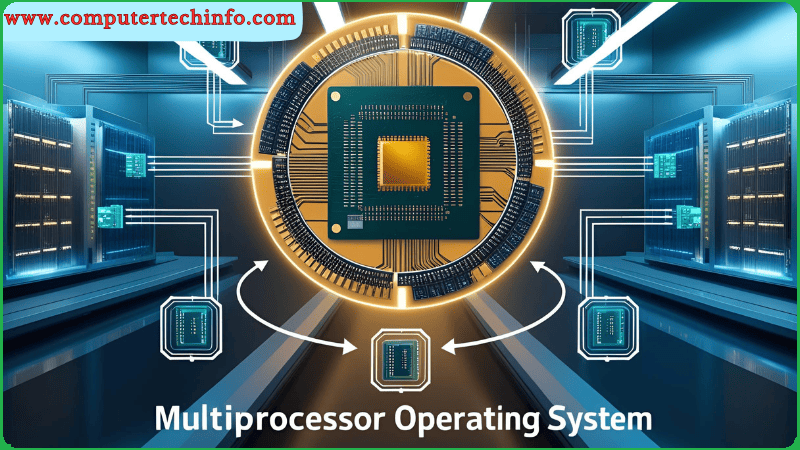What is Multiprocessor Operating System?
Definition: Multiprocessor operating system allows the multiple processors. And these processors get connecting with physical memory, computer buses, clocks, and peripheral devices.
Main objective of using multiprocessor operating system is to consume high computing power and increase the execution speed of system.

Components of Multiprocessor Operating System
There are four major components, which are using in the Multiprocessor Operating System.
- CPU
- Input/Output Processor
- Input/Output Devices
- Memory Unit
CPU – CPU is capable to access memories as well as controlling the entire I/O tasks.
IOP – I/P processor can access direct memories, and every I/O processors have to responsible for controlling all input and output tasks.
Input/Output Devices – These devices are going to use for inserting the input commands, and producing output after processing.
Memory Unit – Multiprocessor system uses the two types of memory modules such as shared memory and distributed shared memory.
Types of Multiprocessor Operating System
Here, We will explain different types of multiprocessor operating system, and classification of its list is done into six types.
- Symmetric Multiprocessor
- Asymmetric Multiprocessor
- Shared Memory Multiprocessor
- Distributed Memory Multiprocessor
- UMA Multiprocessor
- NUMA Multiprocessor
Symmetric Multiprocessor
In this system, every processors have own identically copy of operating system, and they can make communication in between each other. In which all processors connect each other with peer to peer relationship nature, it means no master & slave relation.
Asymmetric Multiprocessor
In this system, every processor is allotted predefined tasks, and master processor has power for controlling entire system. In which, It use the master- slave relationship.
Shared Memory Multiprocessor
In this system, each CPU contains shareable common memory.
Distributed Memory Multiprocessor
In this system, all types of processors consists own private memory.
UMA Multiprocessor
UMA Multiprocessor stands for “Uniform Memory Access Multiprocessor”. In which, it allows to access all memory at the uniform speed rate for all processors.
NUMA Multiprocessor
NUMA Multiprocessor stands for “Non Uniform Memory Access Multiprocessor”. In this system, it involves some areas of the memory for accessing at the faster rate, and left parts of memory get utilizing for other tasks.
Advantages of Multiprocessor Operating System
There are list of several advantages of Multiprocessor operating system such as
Great Reliability
If due to any reason, any one processor gets fails then do not worry because, entire system will do work properly. For example – if multiprocessor has 6 processors and any one processor does not perform properly, at this stage rest of them processors have to responsibilities for handling this system.
Improve Throughput
Enhancing the throughput of system, entire system get improve, if couples of processors work with getting collaboration.
Cost Effective System
Multiprocessor systems are cost effective compare to single processor system in long life because this system is capable to share all input/output devices, power supplies system, and data storage center. In multiprocessor, do not need to connect all peripheral terminals separately with each processor.
Parallel Processing
Multiprocessor O/S gets high performance due to parallel processing. In this system, single job is divided into various same small jobs, and execute them like as Parallel nature.
Disadvantages of Multiprocessor Operating System
- Multiprocessor has complicated nature in both form such as H/W and S/W.
- It is more expensive due to its large architecture.
- Multiprocessor operating system has a daunting task for scheduling processes due to its shareable nature.
- Multiprocessor system needs large memory due to sharing its memory with other resources.
- Its speed can get degrade due to fail any one processor.
- It has more time delay when processor receives message and take appropriate action.
- It has big challenge related to skew and determinism.
- It needs context switching which can be impacted its performance.
Characteristics of Multiprocessor Operating System
There are numerous characteristics of Multiprocessor operating system, explain below
- The Multi processor system allows making communication in between multiple CPUs with their share memory and input/output devices.
- Multi processor system can use different types of processor as per own need, such as central processing unit (CPU) or an input- output processor (IOP).
- Multiprocessors are split into multiple instruction stream multiple data stream (MIMD) systems.
- Entire multi processor system is managed by operating system, and it allows the communication between all processors and I/O devices as well.
- Multi processor has a better reliability.
- If, any processor gets fails due to any reason, then other processor can handle all function of faulty processor.
- Multiprocessor organization provides many benefits for enhancing the system performance.
- Multiprocessing system has a optimize architecture due to implement parallel processing.
- In multiprocessor use different compiler, those are able to identify the parallelism in a user’s program in automation mode.
- Main objective of using the compilers is to determine the all data dependency in the entire program.
- If, any program totally depends upon the data, which created by other programs, then that data executes firstly without getting any delay.
- If, any data gets execute in concurrently, then other parts of the programs can use them.
- Multiprocessors get categorize with their memory management such as shared memory or tightly coupled multiprocessor.
- Every processors is known as loosely coupled system because they contain the own private local memory.
Examples of Multiprocessor Operating System
Examples for Symmetric Multiprocessor – Windows NT, Solaris, Digital UNIX, OS/2 & Linux.
Other Examples for Asymmetric Multiprocessor – SunOS Version 4, IOS
Other Examples are:
- Intel Nehalem – Beckton, Westmere, Sandy Bridge
- AMD Opteron – K10 (Barcelona, Magny Cours); Bulldozer
- ARM Cortex A9, A15 MPCore
- Oracle (Sun) UltraSpare T1, T2, T3, T4 (Niagara)



